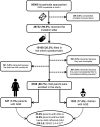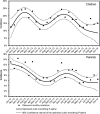Societal Burden and Correlates of Acute Gastroenteritis in Families with Preschool Children
- PMID: 26917406
- PMCID: PMC4768267
- DOI: 10.1038/srep22144
Societal Burden and Correlates of Acute Gastroenteritis in Families with Preschool Children
Abstract
Gastrointestinal infection morbidity remains high amongst preschool children in developed countries. We investigated the societal burden (incidence, healthcare utilization, and productivity loss) and correlates of acute gastroenteritis (AGE) in families with preschoolers. Monthly for 25 months, 2000 families reported AGE symptoms and related care, productivity loss, and risk exposures for one preschooler and one parent. Amongst 8768 child-parent pairs enrolled, 7.3% parents and 17.4% children experienced AGE (0.95 episodes/parent-year and 2.25 episodes/child-year). Healthcare utilization was 18.3% (children) and 8.6% (parents), with 1.6% children hospitalized. Work absenteeism was 55.6% (median 1.5 days) and day-care absenteeism was 26.2% (median 1 day). Besides chronic enteropathies, antacid use, non-breastfeeding, and toddling age, risk factors for childhood AGE were having developmental disabilities, parental occupation in healthcare, multiple siblings, single-parent families, and ≤ 12-month day-care attendance. Risk factors for parental AGE were female gender, having multiple or developmentally-disabled day-care-attending children, antimicrobial use, and poor food-handling practices. Parents of AGE-affected children had a concurrent 4-fold increased AGE risk. We concluded that AGE-causing agents spread widely in families with preschool children, causing high healthcare-seeking behaviours and productivity losses. Modifiable risk factors provide targets for AGE-reducing initiatives. Children may acquire some immunity to AGE after one year of day-care attendance.
Figures


References
-
- Enserink R., Ypma R., Donker G. A., Smit H. A. & van Pelt W. Infectious disease burden related to child day care in the Netherlands. Pediatr Infect Dis J. 32, e334–340 (2013). - PubMed
-
- Doorduyn Y., Van Pelt W. & Havelaar A. H. The burden of infectious intestinal disease (IID) in the community: a survey of self-reported IID in The Netherlands. Epidemiol Infect. 140, 1185–1192 (2012). - PubMed
Publication types
MeSH terms
Substances
LinkOut - more resources
Full Text Sources
Other Literature Sources
Medical

